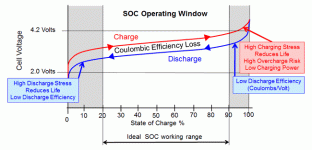helpfulguy
10 W
Is this correct?
If it is, it should be a good way to increase battery life - add 25% energy into your pack and set charger to 80% = profit?
"The battery is rated for 1200 cycles at 0-100% charge until it reaches the 80% of the capacity or 5000 cycles when used 0-80% charge."
Source: http://hybridautocenter.com/HAC4/index.php?option=com_content&view=article&id=72&Itemid=631
Edit: Answer is "YES"
If it is, it should be a good way to increase battery life - add 25% energy into your pack and set charger to 80% = profit?
"The battery is rated for 1200 cycles at 0-100% charge until it reaches the 80% of the capacity or 5000 cycles when used 0-80% charge."
Source: http://hybridautocenter.com/HAC4/index.php?option=com_content&view=article&id=72&Itemid=631
Edit: Answer is "YES"


